Going around in circles (or not)
Tuesday 30 May 2017
 It's Faisal's fault. He started me off on this wild goose chase.
It's Faisal's fault. He started me off on this wild goose chase.
"I don't know how but I probably can."
Foolish statement but the essence of what we are trying to instill in our students. The confidence to tackle problems that we can't see a solution to.
The idea is that my students should make a video explaining a physical concept. Faisal and his team were discussing elliptical orbits and Kepler's laws, but how can you explain Kepler's 2nd law, the one about equal areas in equal times? You can say what it is and you can give examples, show that it's true, even build it in Algodoo, but will the person you are explaining to understand why it is the case.
Is it possible, using only the physics and maths use in this course to explain why Kepler's 2nd law is true? Let's start with the assumption that we accept Newton's universal gravitational law. Using some algebra and the constant acceleration equations can we show that the orbit will be elliptical, let's make it easier (?) given the right conditions conditions will we get a circular orbit?
So far the answer is no.
The idea is to construct an interative model, breaking the motion down into steps so small that we can consider the acceleration to be constant. After each step calculate the angle and use this to calculate the components of acceleration for the next step, sounds good in theory but the nearest I've got to a circle is a squiggle. So far I've spent rather more time than I would like to admit on this problem but it makes a break from crosswords and it's raining again.
Hold on a minute, wasn't the original idea to explain this to someone else? I get lost in my own iterations so I'm not sure if anyone else will understand it.
In the end I put myself out of my misery and looked up the solution. Simple of course. Instead of using sin and cos to get the components of acceleration use similar triangles. Why didn't I think of that.

Now to show that Kepler's second law holds.

Impressive!
Once the spreadsheet is set up it's a simple matter to calculate the KE and PE , then you can show that total energy is constant. All a consequence of Newton's law.

